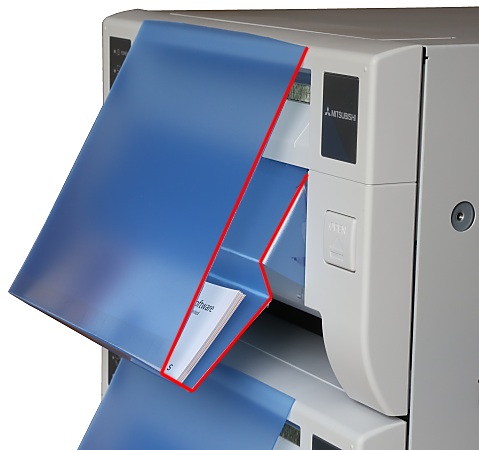There are three main types of printers that can be used for printing flip books: dye sublimation printers, laser printers and inkjet printers.
Dye Sublimation Printers
Dye sublimation printers produce high quality prints that look and feel like traditional photos. The printer is loaded with paper and ribbon and each set of media will give a set number of prints. This means that the cost per print is fixed and the cost won't change however much is printed on each page. The cheaper dye sublimation printers (e.g. DNP DS-RX1) typically take rolls of 200 prints and will print a 6"x4" in around 16 seconds. More expensive dye sublimation printers (e.g. DNP DS40, Mitsubishi CP-D70DW, Mitsubishi CP-D707DW, Sony UP-DR200) are faster (a 6"x4" print takes about 9 secs) and can take rolls of 400 to 700 prints depending on model. The cost per print is less for the more expensive printers. Some dye sublimation printers, such as the Mitsubishi CP-70D, Mitsubishi CP-D707DW, DNP DS40, DNP DS-RX1, HiTi P510L, Sony UP-DR200, can print 6"x2" strips when loaded with 6"x4" media. This greatly simplifies the process of creating the flip books as most of the cutting is done by the printer.
Example US costs using a DNP DS40 dye sublimation printer:
Printer: DNP DS40
Cost: US $1195
Media: 400 6"x4" prints per roll @ $0.15/print
Weight: 31 lbs (14 Kg)
A flip book of 24 pages cut from twelve 6"x2" prints takes approximately 70 secs to print and costs about $1.04
(Prices taken from the Imaging Spectrum website, http://www.imagingspectrum.com, March 2013)
The print catchers that come with dyesub printers aren't suitable for collecting the pages in the order that they are printed. It's worth making a replacement which has a lip so that each page drops down allowing the next page to drop on top. This is simple to make using stiff clear plastic from a craft shop:

The top deck of a Mitsubishi CP-D707DW printer showing the special print catcher made from thin plastic
The step (highlighted in red) allows each strip drop out of the way so that the prints come out in the right order.
Laser Printers
Color laser printers are cheaper to buy than dye sublimation printers and generally print faster but the output is lower quality than with dye sublimation printers or inkjets. Lasers require toner and paper which have to purchased separately and will also need the drum replacing periodically. Toner is the main cost and the amount used will depend on what is printed on each page. Small changes such as using a white background for the photo booth will save toner and reduce the cost of printing. It is also possible to get special drivers for some printers which reduce the amount of toner to save costs. Paper is relatively cheap and a good quality 170 gsm to 200 gsm paper such as Xerox Colotech works well.
Example UK costs using an HP CP2025 Color Laser Printer:
Full set of black, cyan, magenta, yellow cartidges: £392 (source Amazon.co.uk, June 2012)
1000 sheets Xerox Colotech 200 gsm A4 paper: £28.90 (source ebay.co.uk June 2012)
Printer weight: 23 Kg (48 lb)
Printer cost: £311 (source Amazon.co.uk, June 2012)
A flip book of 30 pages cut from 3 A4 prints takes approximately 45 secs to print. Estimated cost per book £1.40
Tips:
| 1. | A free software utility like "Save Toner" can save toner usage by up to 50% |
| 2. | Use a white background to reduce toner usage |
| 3. | Pre-cutting pages into strips using a stack or ream cutter will save time during an event as it reduces the amount of cutting required after printing. e.g. cut US letter 8.5"x11" paper into 4.25"x11" strips before printing and then cut into 2" strips after printing to give the flip book pages |
Inkjet Printers
Inkjet printers are usually the cheapest printers to buy and can give very high quality results when used with good quality inks and paper. However they tend to be slower than dye sublimation printers and laser printers. There is a huge range of different inkjet printers on the market and the cost per print depends on the printer, ink and paper used.
The slower printing speed can be offset to a degree by using Flip Book Photobooth's printer pooling with two or more printers. Individual books are printed on one printer and will take the same time as only using one printer but if several printers are used together several books can be printed in the time it would take to print one book on a single printer. It's also worth looking at more expensive printers as they often have faster printing speeds than cheaper models.
Tips:
| 1. | Use a white background to reduce ink usage |
| 2. | Pre-cutting pages into strips using a stack or ream cutter will save time during an event as it reduces the amount of cutting required after printing. e.g. cut US letter 8.5"x11" paper into 4.25"x11" strips before printing and then cut into 2" strips after printing to give the flip book pages |
Note: Prices are for guidance only and are based on advertised web prices in GB pounds and USD. The relative costs of printers and media may be different in other countries.